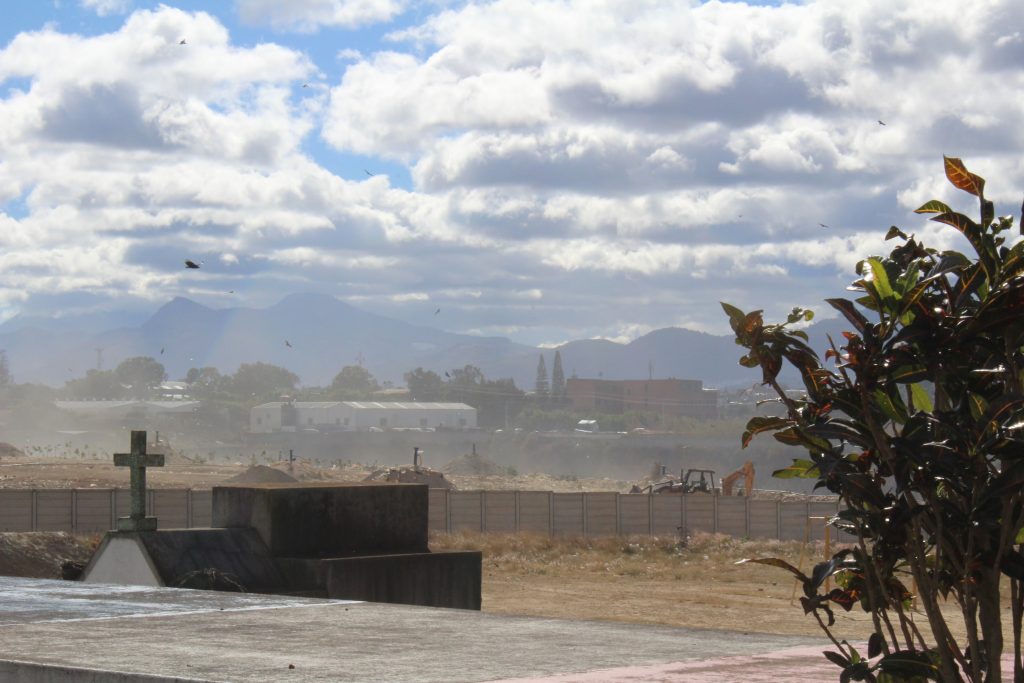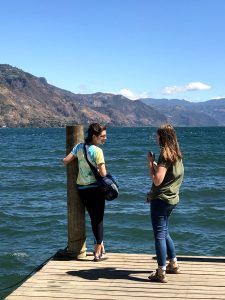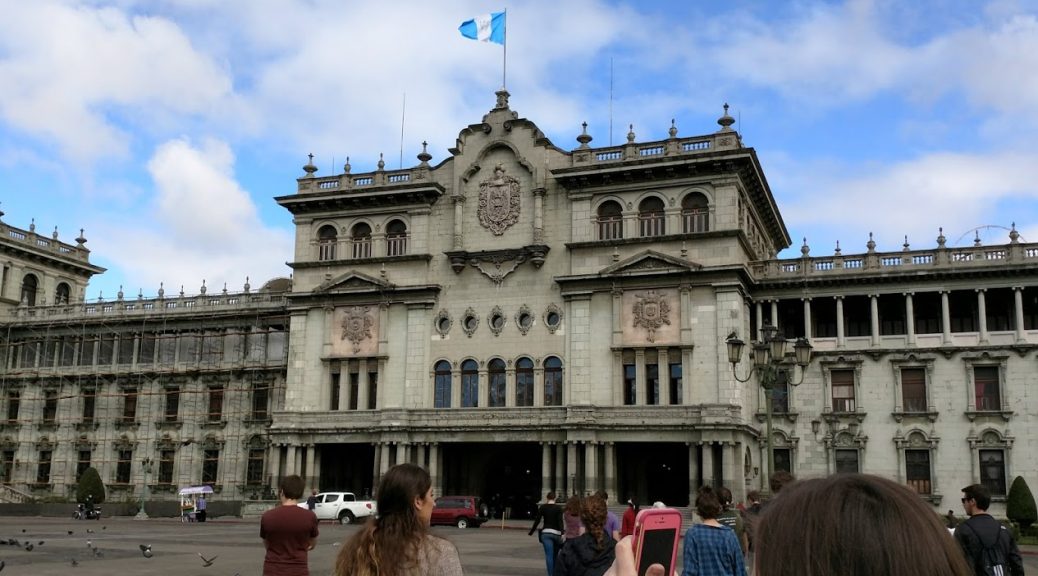Last Tuesday after classes, everyone loaded into the CASAS minivans on an unusual tourist excursion. We were not headed to the national museum, nor to the presidential mansion, but to the cemetery: a resting place for some of Guatemala’s wealthiest elite that also happens to overlook the city dump.
We arrived to elaborate cast iron gates set in a high stucco wall that insulated the cemetery from the noise and bustle of the city. Inside, we found cyprus-draped roads lined by magnificent mausoleums, crumbling monuments, and elaborate marble statuary boasting the remains of some of the city’s best-known generals and politicians. The silent streets were in a surreal state of leisurely decay: gothic spires crumbled after years of neglect, joining the ruins of the long-forgotten Mayan tombs over which the graveyard was constructed in the mid-19th century. Only the monuments of the immortally wealthy—such as the massive [Egyptian] pyramid built in tribute to the Castillo family—escaped the general atmosphere of deterioration.
I wandered down the empty streets with the rest of the group, listening to our guide explain the historical and symbolic significance of the memorials we passed. As we neared the fringes of the cemetery, the decadent, crumbling mausoleums gave way to chaotic walls peppered with tiny marble placards, photographs, and faded silk flowers. Thousands of tiny crypts within these walls held the remains of those who lived by a humbler standard than the elite whose tombs we had seen earlier. But, even these memorials represented a relatively wealthy population: anyone who wished to be buried here had to arrange for an annual rent to be paid postmortem—otherwise their remains would be “evicted” and their crypt would be leased out to someone else.
We had seen the tombs of Guatemala’s wealthiest elite and upper middle class…but where was everyone else? The city’s working class wasn’t buried in the cemetery; they were living in the city dump, or the basurero, located just outside the cemetery. When we arrived at the edge of the cemetery, we found ourselves looking out over an  abyss into which mausoleums crumbled and thousands of vultures swirled in a morbid vigil. I shielded my eyes against the brilliant sun and the wind that carried dust and a putrid odor up from the basurero below. A multitude of people worked mechanically among heaps of garbage. Machinery whined beside them as tractors and trucks hauled in the city’s waste. Workers picked through fresh loads searching for anything marketable or edible.
abyss into which mausoleums crumbled and thousands of vultures swirled in a morbid vigil. I shielded my eyes against the brilliant sun and the wind that carried dust and a putrid odor up from the basurero below. A multitude of people worked mechanically among heaps of garbage. Machinery whined beside them as tractors and trucks hauled in the city’s waste. Workers picked through fresh loads searching for anything marketable or edible.
It was hard to process what I saw at my feet: I was watching an entire community of people picking through garbage for a wage of around $1.25 a day, breathing in the pungent fumes of trash and searching with anticipation for a piece of refuse that might earn them a few centavos. It is a level of poverty that is almost impossible to comprehend, perhaps because its implications are so painful to think about. The people I was watching in the basurero were supporting my comparatively wasteful and extravagant lifestyle: they were picking through trash that I had produced, processing it so that I did not have to see or smell it. At that moment, someone might be picking through my leftovers or examining the empty coffee cup I’d discarded the other day. Why are these people destined to live hand-to-mouth in a pile of trash while I am allowed to splurge on a $3 latte while traveling abroad, during my 17th consecutive year of formal education?
The stark differences between my life and the daily realities of those who live in the basurero is something that is repeated in other dramatic contrasts throughout Guatemala City. I’ve seen huge shopping malls and extravagant gated communities, but I’ve also seen people selling tortillas by the roadside or washing windows at stoplights, hoping to make enough money to buy something to eat at the end of the day. But now what? I’ve seen this contrast and I’ve recognized my own privilege, but will it change the way I live when I go back to the U.S.? I’d like to think that it will, though I’m not yet sure exactly how. At the very least, it is already changing the way I understand the privilege that I experience as a U.S. citizen.
– Kat Lehman
Our trip to Lake Atitlan came at the end of a week focused on contrasts. Specifically contrasts in the different ways of living in Guatemala City. We visited a cemetery where tombs for past presidents and military leaders were beyond extravagant, while the tombs for the average citizen of Guatemala City could only be rented. Laying just past these tombs was the city’s basurero (garbage dump), where we saw men and women sifting through trash, looking for food and items they could sell for approximately 10 Quetzales a day or $1.35. The group excursion the following day consisted of visiting Cayala, a beautiful whitewashed outdoor shopping mall, where a pair of pants were found that cost 698 Quetzales, or approximately $100. A clear contrast to the way of living we had seen the day before.
 The contrasts continued into the weekend as we took a trip to Lake Atitlan, which is a large lake nestled between three volcanoes in Southwest Guatemala that lived up to the pictures and praises we had seen and heard before the trip. The lake was quite different from the city we had been living in for the past two weeks. We took a tour through an organic coffee farm learning about the extra labour necessary to grow and harvest coffee, as well as the environmental benefits this type of farming has for the lake and the surrounding area because of the lack of chemical fertilizers used in the farming. We heard stories about Santiago that took place in the midst of the civil war in Guatemala. Stories of tragic deaths and massacres in communities all around the lake due to the guerilla groups forming camps outside of these towns and the national army’s counterinsurgency campaigns. We also heard about the success Santiago had in coming together as a town after a tragic massacre of 13 people and forcing the removal of the military presence. We learned about their success in resisting the number of attempted returns by the military. And we learned about the deep, rich Mayan culture and their efforts to revitalise this culture as well as old and new influences on this culture that have and continue to change and shape this culture.
The contrasts continued into the weekend as we took a trip to Lake Atitlan, which is a large lake nestled between three volcanoes in Southwest Guatemala that lived up to the pictures and praises we had seen and heard before the trip. The lake was quite different from the city we had been living in for the past two weeks. We took a tour through an organic coffee farm learning about the extra labour necessary to grow and harvest coffee, as well as the environmental benefits this type of farming has for the lake and the surrounding area because of the lack of chemical fertilizers used in the farming. We heard stories about Santiago that took place in the midst of the civil war in Guatemala. Stories of tragic deaths and massacres in communities all around the lake due to the guerilla groups forming camps outside of these towns and the national army’s counterinsurgency campaigns. We also heard about the success Santiago had in coming together as a town after a tragic massacre of 13 people and forcing the removal of the military presence. We learned about their success in resisting the number of attempted returns by the military. And we learned about the deep, rich Mayan culture and their efforts to revitalise this culture as well as old and new influences on this culture that have and continue to change and shape this culture.
These cultures were stark and sometimes rather unsettling, but like much of this trip this week brought about a lot of new questions rather than answering many of the questions we had. This week continued to challenge assumptions and ideas that I had entered this trip with, for which I was very grateful.
-James Paetkau

